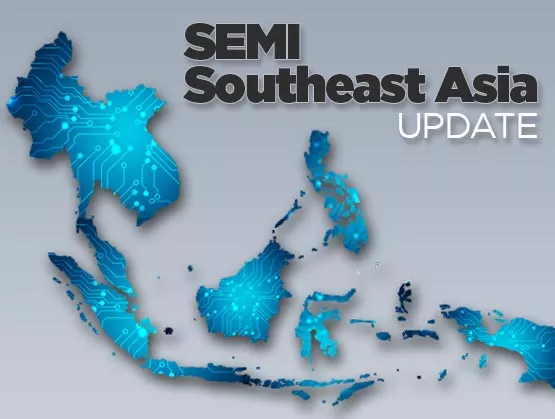
Southeast Asia has emerged as a potent force in the global semiconductor ecosystem in recent years, driven by strong government support, a skilled workforce, and a favorable business environment. Many Southeast Asian countries have implemented policies and initiatives to better support the region’s growth and strengthen its semiconductor ecosystem.
Singapore for example, has invested heavily in R&D, infrastructure, and talent development to build a vibrant semiconductor ecosystem as it aims to grow its manufacturing industry by 50% by the end of 2030. The region boasts more than 30,000 highly skilled engineers and technicians well-trained in semiconductor design, manufacturing, and testing, according to Economic Development Board of Singapore. What’s more, Singapore pro-business government policies include lower tax rates and streamlined regulations, drawing technology giants such as Apple, Google and Samsung in recent years.
These dynamics have powered robust growth of Southeast Asia’s semiconductor industry in recent years – projected at a Compound Annual Growth Rate (CAGR) of 5.2% between 2021 and 2026 according to a report by TechSci Research.
With semiconductors at the heart of the digital revolution, powering everything from smartphones and laptops to self-driving cars and the Internet of Things (IoT), long-term prospects for the industry and business confidence in Southeast Asia as a key chip hub remains strong, with several factors expected to drive continued growth in the coming years:
- Rising demand for semiconductors: As digital technologies continue to proliferate across industries, demand for semiconductors is expected to rise, driving rising investments in the global semiconductor industry, and particularly in the SEA region, with its large and growing market for digital products and services. According to Statista, revenue in the SEA market is projected to reach US$101 billion in 2023.
- Growing investment in R&D: Many SEA countries are investing heavily in R&D to support semiconductor industry growth. Focus areas of investment include artificial intelligence (AI), machine learning, and 5G – all drivers of semiconductor industry innovation and growth.
- Emergence of new applications: New applications such as autonomous vehicles are expected to increase demand for semiconductors in the coming years, creating new opportunities for SEA semiconductor companies, particularly those with expertise in areas such as sensor technology and wireless communications such as ASM International and Qualcomm.
 In the area of workforce development, SEMI launched the global SEMI University online learning management system in February. And at SEMI Southeast Asia, we continue to implement talent initiatives to strengthen the region's position as a global manufacturing hub. For example, in March this year we formed the SEA Workforce & Talent Development Council comprising representatives from AEM Corporation, Applied Materials, GlobalFoundries, Inari Amertron, KLA Corporation, Nexperia, TF-AMD and ViTrox, with the aim to address the workforce and talent pipeline challenges.
In the area of workforce development, SEMI launched the global SEMI University online learning management system in February. And at SEMI Southeast Asia, we continue to implement talent initiatives to strengthen the region's position as a global manufacturing hub. For example, in March this year we formed the SEA Workforce & Talent Development Council comprising representatives from AEM Corporation, Applied Materials, GlobalFoundries, Inari Amertron, KLA Corporation, Nexperia, TF-AMD and ViTrox, with the aim to address the workforce and talent pipeline challenges.
We also developed a new boot camp featuring soft skills training and programs curated by participating companies such as GlobalFoundries and InvestPenang to attract top talent in collaboration with selected institutes of higher learning in Southeast Asia, such as Singapore University of Technology and Design (SUTD) and Singapore Polytechnic. The boot camp will launch at SEMICON Southeast Asia later this month.
We look forward to welcoming the global chip supply chain to exhibition and conference, and excitement around the event is high. Reflecting the strong and growing business interest in SEA, we sold out of booth space three months before the show. New to the exhibition and conference will be SMART Mobility and Smart MedTech tracks. Registration for the event is open.
New at SEMICON Southeast Asia!

As part of our continuing efforts to expand the region’s semiconductor industry footprint, we will create more value for member companies, particularly small and midsize enterprises, by helping them grow their international presence through SEMI platforms. This year we will again hold the Vietnam Business Summit – Sept. 27-28 in Hanoi – to highlight growth opportunities in Vietnam’s semiconductor industry and across the Southeast Asia electronics ecosystem. We also plan to explore the dynamics of the Thai semiconductor ecosystem with a roundtable discussion scheduled for August 2023 in Thailand.
 I would also like to take this opportunity to share the importance of sustainability in our ecosystem. This is a topic that SEMI Southeast Asia, and I personally, take to heart. While many individual companies in our industry have taken steps to decarbonize, I believe the industry must band together to develop green solutions and drive toward net zero. As such, I encourage all of you to learn more about the Semiconductor Climate Consortium (SCC), an industry group working to accelerate efforts to reduce greenhouse gas emissions across the chip industry value chain. SEMI Southeast Asia facilitated efforts of four companies in the region to join the consortium.
I would also like to take this opportunity to share the importance of sustainability in our ecosystem. This is a topic that SEMI Southeast Asia, and I personally, take to heart. While many individual companies in our industry have taken steps to decarbonize, I believe the industry must band together to develop green solutions and drive toward net zero. As such, I encourage all of you to learn more about the Semiconductor Climate Consortium (SCC), an industry group working to accelerate efforts to reduce greenhouse gas emissions across the chip industry value chain. SEMI Southeast Asia facilitated efforts of four companies in the region to join the consortium.
We believe that the collaboration of our member companies, with our accumulated knowledge and innovative technology, will accelerate solutions to the most pressing problems. Working together, we will address and solve issues no one company can do alone.
Linda Tan is President of SEMI Southeast Asia.